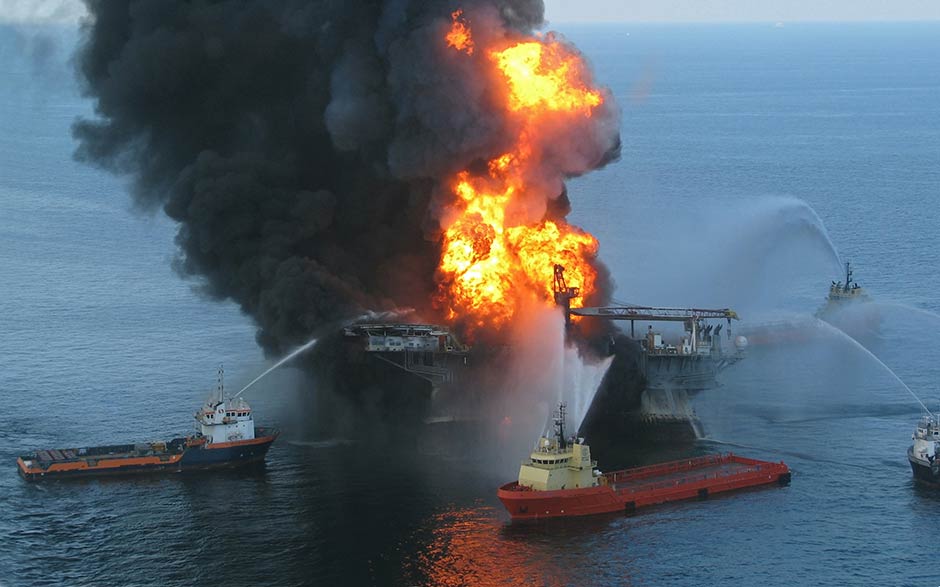
A Gulf Boat Captain Reflects on Deepwater Horizon 15 Years Later
In 1926, my grandfather, a fisherman by trade, began ferrying locals and tourists out to the Mississippi islands in the Gulf of Mexico on a converted wood oyster schooner. Nearly 100 years later, using my family’s hundred-foot passenger ferry, I’ve continued the business of transporting people across the shallow, brackish Mississippi Sound out to the emerald-green waters of the Gulf Islands National Seashore. Fifty-thousand visitors from across the country travel here each year to discover the beauty and solitude found on some of the last undeveloped islands in the Northern Gulf region.
Our family business has weathered notable storms, like Hurricanes Camille in 1969, and Katrina in 2005. We’ve also had to weather some human-made events. The Great Depression made landfall less than a decade after my grandfather carried his first passengers. The islands were closed to the public during World War II. Other financial challenges came and went over the decades. But 15 years ago, one crisis left an indelible mark on our business: British Petroleum’s Deepwater Horizon, the largest marine oil spill in the history of the petroleum industry.
On April 20, 2010, not long after the opening of our ferry season, BP’s ultra-deepwater oil drilling rig, just 80 miles south of us, experienced a major blowout and explosion. The disaster caused the death of 11 people and eventually released 134 million gallons of oil that covered 1,300 miles of shoreline across five states and contaminated an area in the Gulf the size of Virginia. Over the 87 straight days BP’s damaged pipeline spewed oil into the sea, I wondered whether this would mean the end of my family’s business. We lost the entire season that year and saw a significant drop in ridership in the years after.
This single oil spill would eliminate 25,000 jobs in the Gulf region, including from businesses like mine that rely on the pristine Gulf for tourism, fishing, and other ventures. It would be like shaving off 10 percent of the jobs that were just added to the U.S. in March. Ultimately, Deepwater Horizon cost $17.2 billion in damage (by comparison, the federal government collected $10 billion less in offshore oil and gas tax revenue in 2024).
Beyond the thousands of jobs that were wiped away, countless fish, birds, sea turtles, whales, and other marine life perished in the toxic, suffocating sludge. I worried for the survival of the Atlantic bottlenose dolphin population in the Mississippi Sound that have escorted my boat and spread joy to my passengers for the past 49 years. The excitement that dolphin sightings bring to people, especially children, is the most satisfying part of my job. Seeing the dolphins has reliably lifted my spirit, too.
I was left without words after learning about so many dead and dying dolphins. According to NOAA, BP’s oil spill caused the largest and longest lasting cetacean mortality event ever recorded for the Gulf. One whale species, the Rice’s whale, which is endemic to the Gulf, saw 20 percent of its population decimated. There are now only an estimated 51 remaining whales. Scientists have warned that the loss of even a single reproductive female whale would jeopardize the existence of this species. This would represent the first human-caused extinction of a great whale in history. Ahab himself would shudder.
One of the less reported impacts of Deepwater Horizon was BP’s Corexit operation. Corexit is a chemical that breaks oil down to more easily mix with water, so the oil can sink and “disappear” from view. But both the oil and this highly toxic chemical (which former Senator Mikulski likened to Agent Orange) remain in the ocean. The chemical is so harmful, in part due to the lasting toxicity it introduces to ecosystems, that the U.K. banned its use on oil spills. BP chose to conduct its Corexit operations at night. I remember the air being toxic to breathe. Shrimpers became ill after touching nets pulled over areas containing Corexit-laced oil. Numerous beach clean-up workers sought medical help after coming into contact with contaminated “tar balls” and other debris. Traces of Corexit are likely still present in areas of the sea floor off the Mississippi coast.
Fifteen years after Deepwater Horizon, while the more blatant effects are less visible, the wound is still alive, as is the memory — and fear for the next one. In fact, BP is pursuing a new massive offshore drilling operation called Kaskida, which it wants to begin in 2029. Kaskida would operate in even deeper water, though those depths are significantly riskier. This represents a broader trend. Since 2010, the oil industry has moved into deeper water: in the last five offshore lease sales, over 60 percent of new industry bids went for deep or ultra-deepwater. This is happening even as oil companies sit on millions of acres of unused ocean leases, many of them in much shallower water. Meanwhile, hurricanes are growing stronger and more destructive each year due to abnormally warm oceans, making oil spills all the more likely.
In 2026, the hundredth year of my family’s company, I plan to retire and pass along this business to my son like my father did with me. After Deepwater Horizon, I realized my family’s business, the national seashore, and our way of life along the Mississippi Gulf coast are now in jeopardy from a seemingly unrelenting policy of “drill, baby, drill.” Unless the government puts an end to leasing risker waters to oil companies, I fear my son and his generation will experience the pain and hardship of another oil spill that will ruin what’s left of our precious marine resources, and the livelihoods of many.